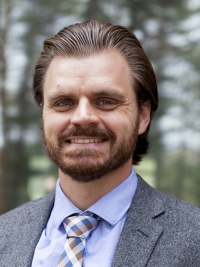

Ryan Nielson T’18 is an investment banking associate at Credit Suisse in Houston, Texas. He continues to support Tuck by connecting with students who are exploring finance roles in Houston. Prior to Tuck, he spent 5 years with the United States Navy as a nuclear power research project officer in Washington, D.C. Ryan was responsible for reactor design, maintenance, operation, and disposal in Los Angeles Class submarines. As a “career switcher”, Ryan interned at Tuckerman Capital, a middle-market industrial and manufacturing private equity firm in in Hanover, NH. In addition to being a Revers Energy Fellow, he also co-chaired the Tuck Outdoors Club. Ryan holds a B.S. in Mechanical Engineering from Brigham Young University and a M.E. in Nuclear Engineering from Pennsylvania State University.
1. What was the most important part of your Tuck experience that you’ve taken with you to your job and/or life?
The friendships I formed at Tuck, the mentors that took me under their wing, and the overall focus on human capital in all aspects of life. I think of my experience at Tuck as two years of conversation and connection. The habits of communication, community building, and shared experience that I developed at school have become part of my everyday professional and personal habits after graduation.
2. What are some of the biggest challenges that you think investment banking will face in the energy field?
As a consequence of the Saudi-Russia tension and COVID-19, oil and gas is experiencing the most significant commodity price and stock price pressure since the Gulf War. This presents three major challenges to investment banking: (1) liquidity of independent upstream companies; (2) access to capital markets; and (3) a fundamental change in operating philosophy of reduced drilling and an intense focus on cost reduction. The root of current liquidity issues is semiannual reserved based lending credit facility borrowing base redeterminations. Given a c. 50 percent reduction to WTI Oil price since the last redetermination, companies should expect banks to downsize the borrowing available under all credit facilities this Spring, resulting in default and immediate capital calls by many companies who are currently heavily drawn or depend on credit facilities to fund drilling programs. To compound the issue, oil weighted E&P company stock prices are down 60+%, the energy sector share of the S&P is at an all-time low, and debt market yield spreads have widened, making refinancing of borrowings under the revolver and financing corporate development plans challenging. Consequently, we have already seen announcements from most E&P operators to slash 2020 drilling and development in an attempt to free up cash flow and slow growth.
3. How do you expect the type of transactions to change, if at all, in the energy space?
I expect transactions to focus on restructuring, 1st lien / mezzanine debt and select mergers & acquisitions. I also expect investors to continue their flight to quality, focusing resource on cash-flowing businesses with low decline, sufficient scale to allow for differentiated cost performance, and economic inventory at low break even.
4. What advice would you give to current students interested in working in energy finance?
The energy ecosystem is broad, interconnected, and complex. It pays to gain a cursory understanding of economics and markets, power generation industry, emerging efficiency and clean technology, and natural resources that underpin the infrastructure. Try to develop an integrated view of the challenges facing the industry and society. Eventually everyone develops a niche, but I think it pays to stay flexible in a sector that is highly cyclical, politically charged and undergoing rapid disruption.
5. Favorite place in the Upper Valley? In Houston?
I’m a big fan of Quechee and Woodstock with a special shout-out to the Pogue for a nice trail run. In Houston, I have to mention the steak and cocktail scene, probably led by BB Butcher and Julep.
The Revers Center for Energy’s mission is to inspire and shape tomorrow’s leaders in energy while engaging today’s energy community.